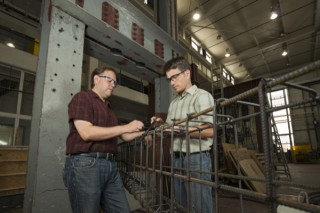An interdisciplinary team of researchers from the University of Delaware are involved in the development of a structural health monitoring system based on composites incorporating carbon nanotubes.

Erik Thostenson (left) and Thomas Schumacher in UD’s Center for Composite Materials
The National Science Foundation has awarded a US $300,000 grant to be disbursed over a three-year period to affiliated faculty members Thomas Schumacher and Erik Thostenson at the University of Delaware’s Center for Composite Materials for the study. The research initiative comes in the wake of the I-35W Bridge collapse over the Mississippi River in August 2007 in Minneapolis. The collapse was the result of a design deficiency that led to the failure of a gusset plate when construction was in progress.
The UD researchers will assess the potential application of carbon nanotubes composites as a “smart skin” for structures. Initial investigations demonstrated that carbon nanotubes hybrid glass fiber composite served as a continuous conductive skin when attached to small-sized beams of concrete. The conductive skin was found to be extremely perceptive to alterations in strain and also to the inception and aggravation of damage.
According to Schumacher, the sensor can be incorporated as a structural element wherein the hybrid fiber composite strengthens the damaged structure or can be integrated as a sensing element with no structural function. The uniqueness of the carbon nanotubes is their ability to completely merge with the composites to form an advanced fiber based composite system that retains its microstructure but features new functionality as a result of the nanotubes. The main advantage of this hybrid fiber composite sensor is its ability to bond to existing structures irrespective of their shape or to be developed into new structures at the time of construction.
Source: http://www.udel.edu/
Disclaimer: The views expressed here are those of the author expressed in their private capacity and do not necessarily represent the views of AZoM.com Limited T/A AZoNetwork the owner and operator of this website. This disclaimer forms part of the Terms and conditions of use of this website.